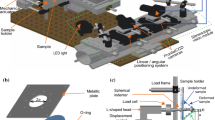Abstract
Uniaxial tension tests were performed on the Kevlar-filled EPDM rubber sheet. The short Kevlar fibers are found to align approximately in a single direction. Tensile specimens are thus cut along two different directions, one along the fiber alignment direction (designated as the H specimens) and the other perpendicular to the general fiber direction (the V specimens). The non-contact, optical technique of digital image correlation (DIC) is used to map out the displacement field over the sample surface and the stretches in the loading and the lateral directions are determined from the local displacement measurement. We find that the mechanical response of the Kevlar-filled EPDM rubber sheet along the Kevlar fiber direction is markedly different from that perpendicular to the fiber direction. The Kevlar-filled EPDM rubber sheet has a much higher tensile strength in the Kevlar fiber direction but with less ductility, while the tensile strength is lower in the direction perpendicular to the Kevlar fiber but the ductility is much larger. Failure mechanisms are proposed based on the observation of features of the teared surfaces, and the mechanical parameters that may be related to the mechanical failure are speculated on as well. A non-uniform deformation field develops within the gage section of the specimen and the pattern of the non-uniform deformation is found to correlate with the Kevlar fiber orientation and distribution. In addition, tensile specimens subject to cyclic loadings are tested in the two fiber orientations and the so-called Mullins effect is observed and recorded.














Similar content being viewed by others
Data Availability
Data will be made available on reasonable request.
References
Bruck, H., McNeil, S., Sutton, M., Peters, W.: Digital image correlation using Newton-Raphson method of partial differential correction. Exp. Mech. 29, 261–267 (1989)
Bueche, F.: Molecular basis for the Mullins effect. J. Appl. Polym. Sci. 4, 107–114 (1960)
Bueche, F.: Mullins effect and rubber-filler interaction. J. Appl. Polym. Sci. 5, 271–281 (1961)
Chu, T., Ranson, W., Sutton, M., Peters, W.: Applications of digital image correlation techniques to experimental mechanics. Exp. Mech. 25, 232–244 (1985)
Diani, J., Fayolle, B., Gilormini, P.: A review on the Mullins effect. Eur. Polym. J. 45, 601–612 (2009)
Dorfmann, A., Ogden, R.: A constitutive model for the Mullins effect with permanent set in particle-reinforced rubber. Int. J. Solids Struct. 41, 1855–1878 (2004)
Govindjee, S., Simo, J.: A micro-mechanically based continuum damage model for carbon black-filled rubbers incorporating the Mullins effect. J. Mech. Phys. Solids 39, 87–112 (1991)
Harwood, J., Payne, A.: Stress softening in rubber vulcanizates. Part III. Carbon black-filled vulcanizates. J. Appl. Polym. Sci. 10, 315–324 (1966)
Harwood, J., Mullins, L., Payne, A.: Stress softening in rubber vulcanizates. Part II. Stress softening effects in pure gum and filler loaded rubbers. J. Appl. Polym. Sci. 9, 3011–3021 (1965)
Knauss, W., Chasiotis, I., Huang, Y.: Mechanical measurements at the micron and nanometer scales. Mech. Mater. 35, 217–231 (2003)
Krishnaswamy, S., Beatty, M.: The Mullins effect in compressible solids. Int. J. Eng. Sci. 38, 1397–1414 (2000)
Liechti, K., Chai, Y.S.: Asymmetric shielding in interfacial fracture under in-plane shear. J. Appl. Mech. 59, 295–304 (1992)
Mullins, L., Tobin, N.: Stress softening in rubber vulcanizates. Part I. Use of a strain amplification factor to describe the elastic behavior of filler-reinforced vulcanized rubber. J. Appl. Polym. Sci. 9, 2993–3009 (1965)
Ogden, R., Roxburgh, D.: A pseudo-elastic model for the Mullins effect in filled rubber. Proc. R. Soc. Lond. A 455, 2861–2877 (1999)
Sutton, M., McNeill, S., Helm, J., Chao, Y.: Advances in two-dimensional and three-dimensional computer vision. Top. Appl. Phys. 77, 323–372 (2000)
Vendroux, G., Knauss, W.: Submicron deformation field measurements: part 2. Improved digital image correlation. Exp. Mech. 38, 86–92 (1998)
Acknowledgements
Los Alamos National Laboratory is operated by Triad National Security, LLC, for the National Nuclear Security Administration (NNSA) of U.S. Department of Energy (Contract No. 89233218CNA000001). This study was supported by the Joint DoD/DOE Munitions Program (JMP).
Author information
Authors and Affiliations
Corresponding author
Additional information
Publisher’s Note
Springer Nature remains neutral with regard to jurisdictional claims in published maps and institutional affiliations.
Rights and permissions
About this article
Cite this article
Liu, C. Uniaxial tension of Kevlar-filled EPDM rubber sheet: effect of fiber orientation and distribution. Mech Time-Depend Mater 26, 683–697 (2022). https://doi.org/10.1007/s11043-021-09507-y
Received:
Accepted:
Published:
Issue Date:
DOI: https://doi.org/10.1007/s11043-021-09507-y




